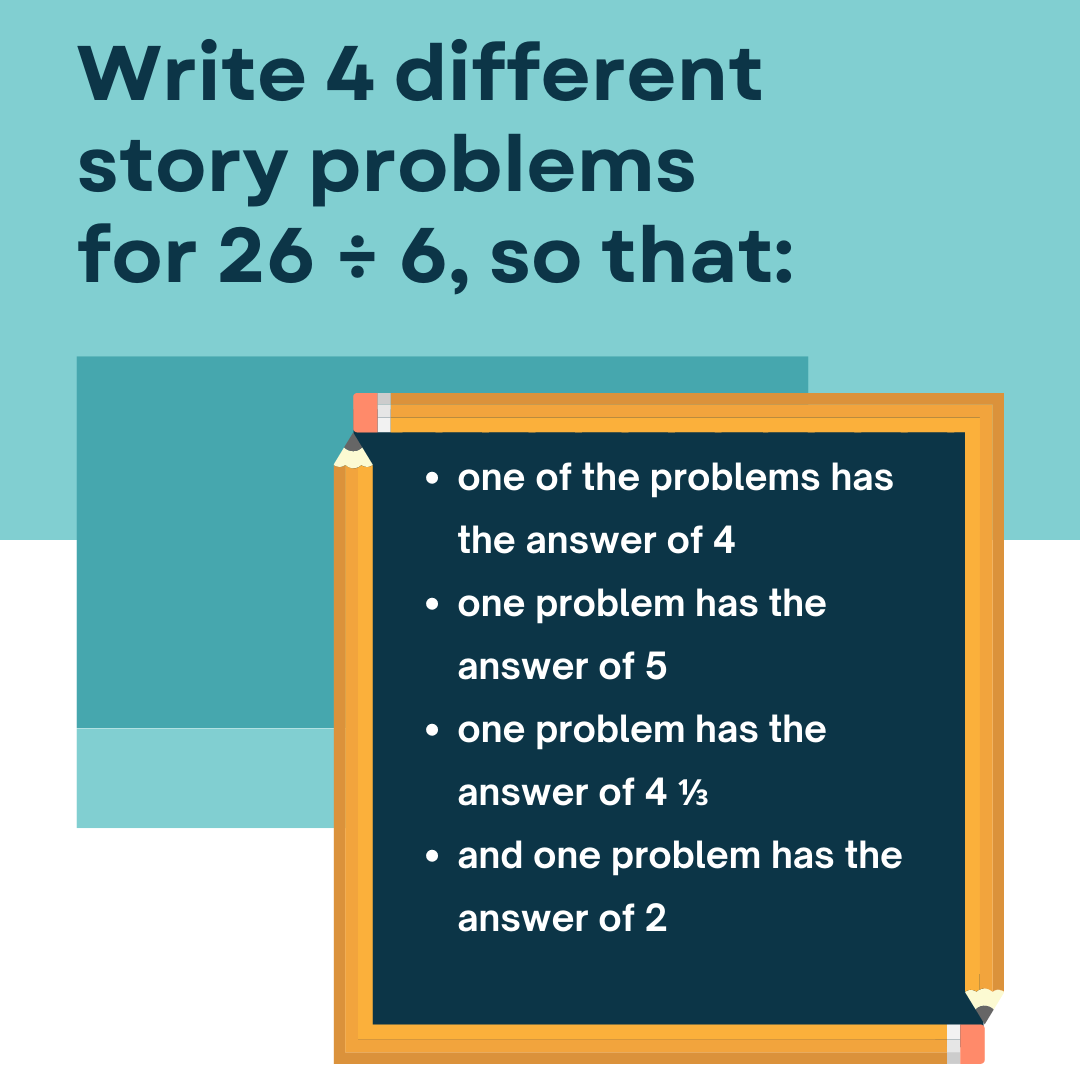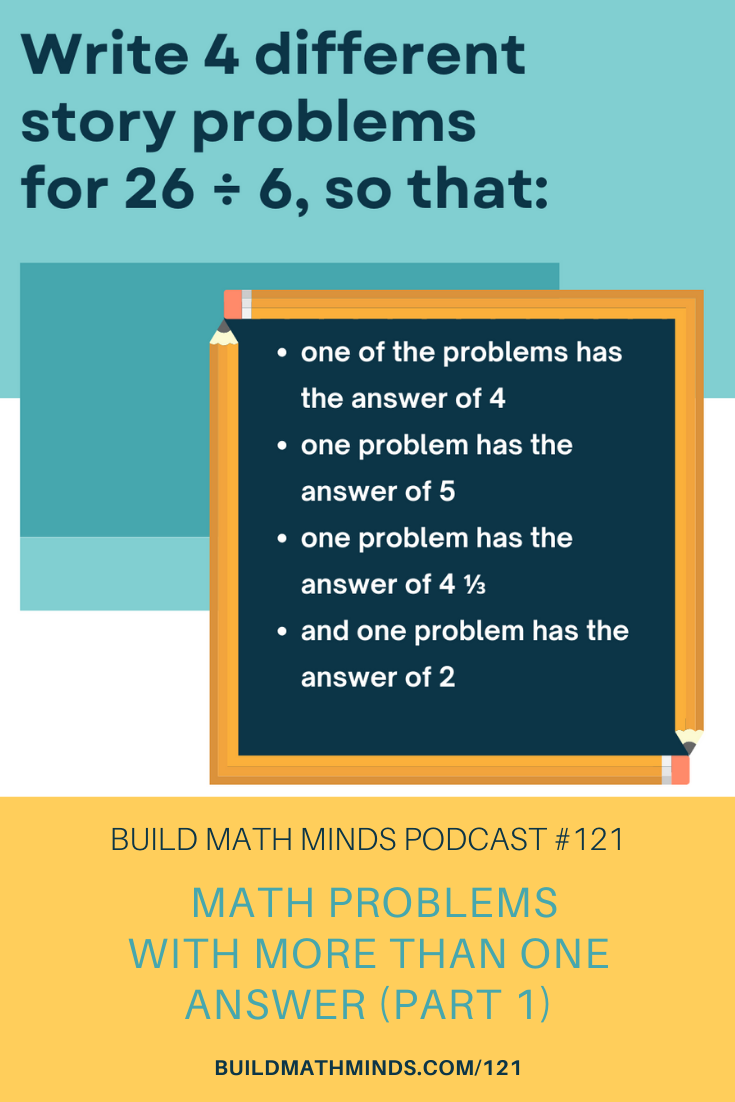Resources mentioned in this episode:
Children’s Mathematics: Cognitively Guided Instruction by Thomas Carpenter, Elizabeth Fennema, Megan Loef Franke, Linda Levi, Susan B. Empson
Welcome fellow Recovering Traditionalists to Episode 121. Today I’d like to talk about Math Problems With More Than One Answer (Part 1).
There are a handful of moments that resonate with me still today that happened when I started to make a change in my teaching of mathematics. One of those moments was the day I realized that a math problem could have more than one answer. I’d like to say that it was when I was a kid, but this moment actually happened when I was getting my master’s degree.
One of my professors put up a problem similar to this one (I don’t remember the exact problem):

For those of you trained in Cognitively Guided Instruction you know where this is going. CGI is where my professor got the problem from. For any of you who are like me and thought math problems only have one answer, I’m going to encourage you to press pause on this episode and go work on this for yourself.
I was able to get the 4 ⅓ right away. Because to me, back then, that was the only answer to this problem. When you divide 26 by 6 you get 4 and 2/6 which reduces to 4 ⅓ (yes, I said ‘reduce’ instead of ‘simplify’ because that’s the way I was taught and I was taught you always must reduce fractions to their simplest form and if I would have given the answer as 4 2/6 it would have been marked as wrong).
Here is an example of a story problem that would have an answer of 4 ⅓:
Christina made 26 cookies. She has 6 people in her family and wants to give everyone the same amount of cookies. How many cookies will each person get?
The situation makes it so that the leftover cookies (aka The Remainder) need to be divided up. Not sure about everyone’s households, but if there are some cookies left on the table in my house, my kids are quick to figure out what is happening with them.
So as I said, writing a story problem that gave the exact answer of 4 ⅓ was not a problem for me. The next one that came to me was the answer of 4, I think it was because I saw the 4 appear in the actual answer. So I wrote something like this:
Christina made 26 cookies. She has 6 people in her family and wants to give everyone the same amount of cookies. How many cookies will each person get? (if there are leftovers, we will save them for friends who come over)
Yup, all I added was the little bit about ignoring the leftovers. But, my professor challenged me to find a situation where you would naturally ignore the leftovers. If I have to write extra instructions into my story problem, then it isn’t a realistic problem for the kids.
It took me a bit but I came up with a scenario like this:
Christina has $26. She found a toy she wants to buy for her friends that costs $6. How many toys can she buy?
This scenario naturally has you ignore the leftover amount because you can’t use that leftover money to do anything with it. I can’t buy ⅓ of a toy, so I end up ignoring my leftover money.
As I was writing that problem, it came to me that if I didn’t have enough money to buy 5 toys….there’s my 5!!! So somehow I needed to write a problem that rounds up….but naturally makes you want to round up.
There are 26 kids going on our field trip. Six kids can each fit in the vans we are taking on our trip. How many vans do we need for our field trip?
With this scenario we can’t have ⅓ of a van and as much as sometimes we want to leave a few kids back at school on our field trip days, we can’t just ignore the leftover kids…we have to get that 5th bus for the extra kiddos.
Now some of you who are listening are probably screaming at your device saying “Christina, the one with the 2 as the answer is the easiest problem! Why haven’t you talked about it yet????” Well, to be honest, I sat in that class completely stumped on how to write a story problem using 26 ➗ 6 that would give me the answer of 2….yet at the end of the time when we got to go around and read what other people had written it was a total face-palm moment for me. Like how did I NOT see that!??!?
Christina has $26. She found a toy she wants to buy for her friends that costs $6. How many toys can she buy?
Yes this one is starting off just like one I had before…but the change in the answer happens when you change what question you ask.
Christina has $26. She found a toy she wants to buy for her friends that costs $6. How many toys can she buy? How much money does she have leftover?
Yup, it was right in front of my face the entire time and I never saw it. But when we did our class discussion, so many people in the class said the 2 was the easiest one for them to write. They saw that first before the others.
Even though I just spent the entire time talking about division with remainders and all the ways you can write story problems for one problem, this episode isn’t about division with remainders.
It’s about opening our minds to the idea that math isn’t just about getting one correct answer. A problem that involved division with remainders did that for me, but for young kids they might have that same realization that I did when you show an image with dots and ask them how many they see and how they figured it out. As more and more kids share the different ways they figured it out, they see that there is more than one right way to solve it…that’s just as powerful as realizing that sometimes there is more than one answer to a problem. As you work to encourage your students to think outside the box, share their way of thinking, it makes them more curious…it makes them question things…it makes them see that math problems should make sense, not just be manufactured situations that really don’t make sense in the real world.
So keep on working to build your students’ math minds and today was just about opening our minds to the idea that math problems can have more than one answer. Yes, there are a lot of math problems that only have one answer. But, there are problems that can have more than one answer and all math problems have more than one way to get to the answer. In a future episode, I’m going to share with you math activities that you can use, no matter what grade level you teach, that have math problems with more than one answer.
If you want to see these problems instead of just listen to them, you can read through the transcript over at buildmathminds.com/121
If you like what you have been hearing there are a few ways I would love for you to let me know. The first way is to subscribe to the podcast. If you are listening in iTunes make sure to hit that subscribe button. Also in iTunes I would love for you to leave a review and let me know if you are enjoying the podcast which types of episodes are your favorite. Really just anything to get me feedback about the show and lastly if you are on Instagram or Twitter I would love for you to share when you listen to an episode that you love. Make sure you tag me @buildmathminds and all of those are the ways to let me know that there are actually people out there listening. Thank you so much for letting me be a small part of your math journey
Subscribe and Review in iTunes
While you’re there, don’t forget to leave a review on iTunes too. I would love to know your thoughts and how we can make sure that we give you content that you will really enjoy.
To leave a review, head over to iTunes and click on “Ratings and Reviews” and “Write a Review.” I can’t wait to hear your thoughts about the podcast.




